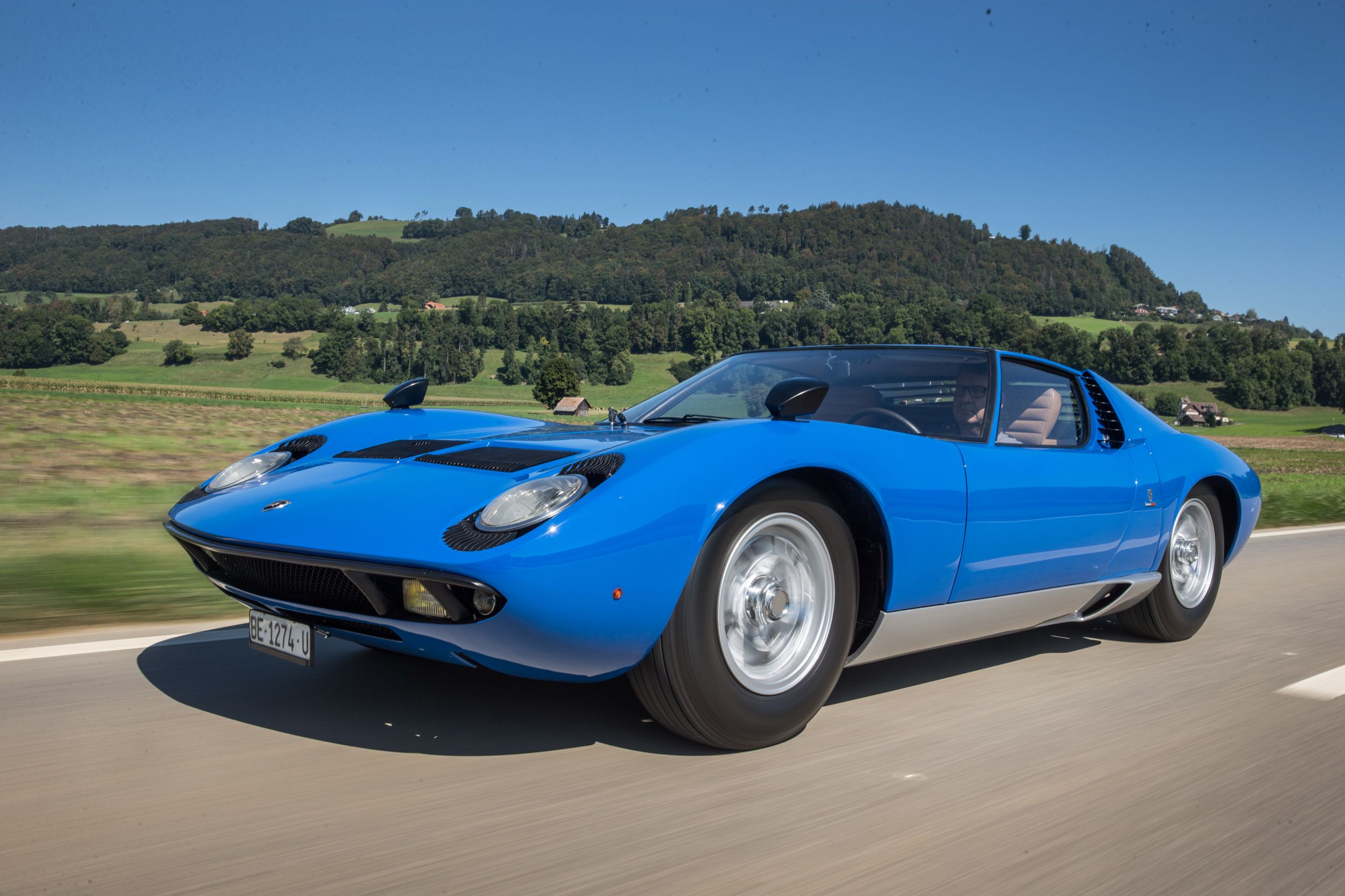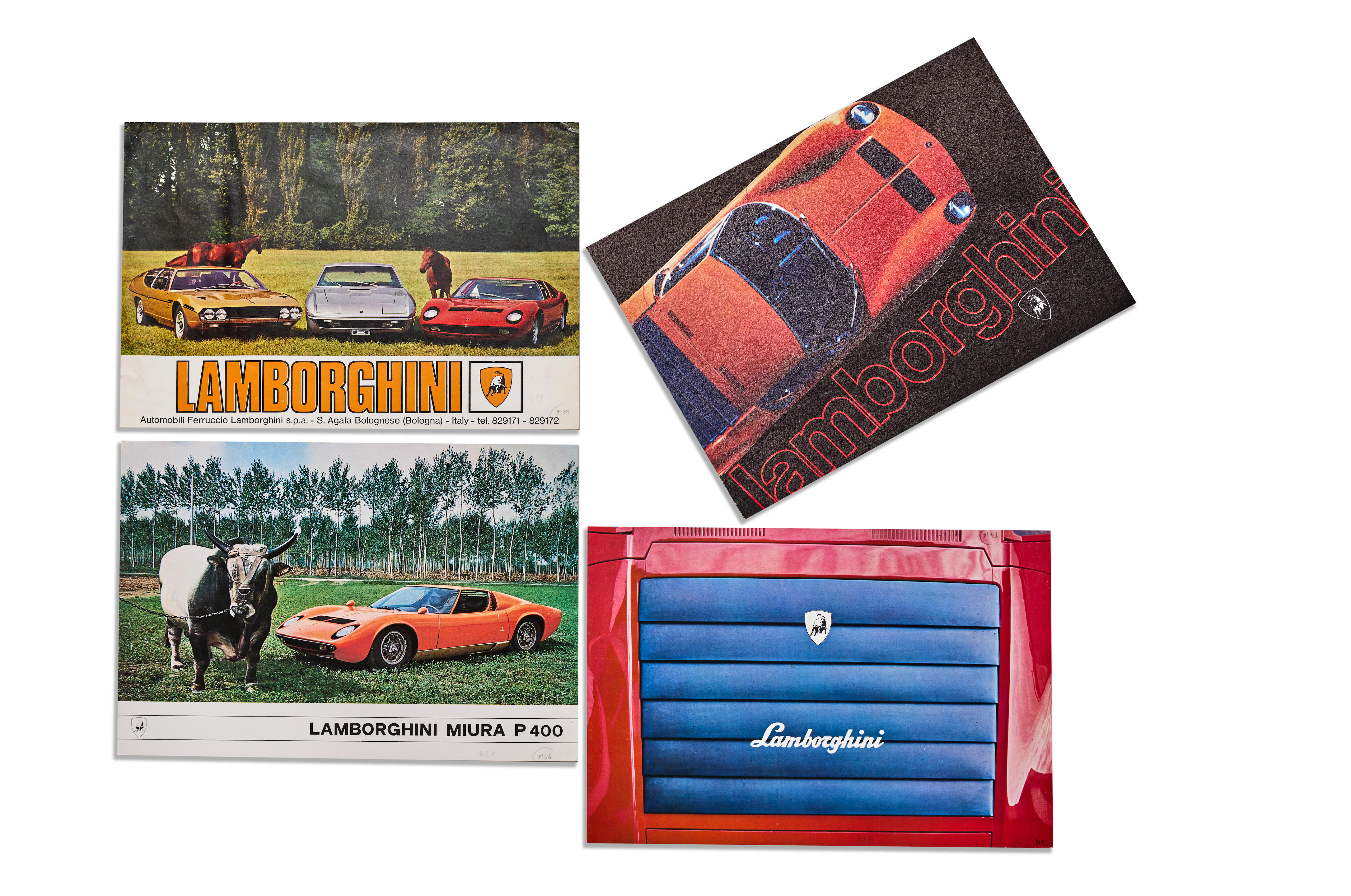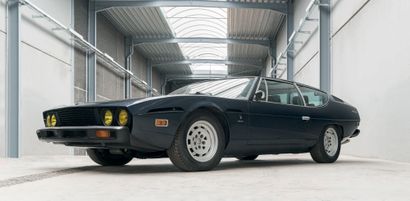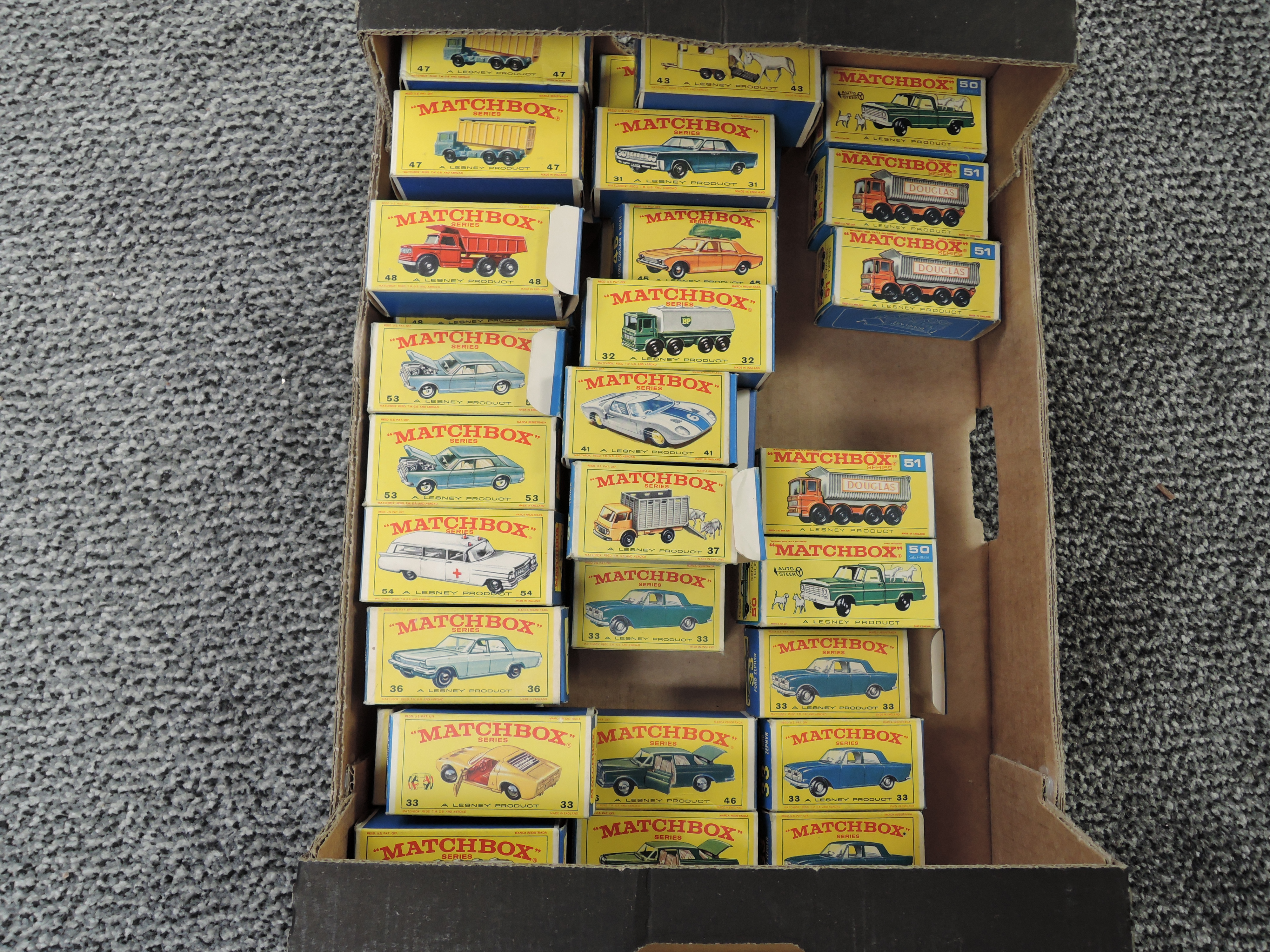3,929cc DOHC All-Alloy V12 Engine
4 Triple-choke Weber Carburetors
350bhp at 7,000rpm
5-Speed Manual Transaxle
4-Wheel Independent Suspension
4-Wheel Disc Brakes
*Superb, factory-correct restoration performed by Bobileff Motorcar Company
*Matching-numbers example, retaining its original Bertone bodywork
*Award-winning, US-market car from new, fitted with factory air conditioning
*Offered with comprehensive history file containing copies of both factory and restoration records, and full tool roll
THE LAMBORGHINI MIURA
One glance at the stunning Miura and you cannot help but think of Rossano Brazzi gliding through the Alpine passes in the opening sequences of the famed British heist movie, The Italian Job. You'll probably find yourself humming Matt Monro's, "On Days Like These," too. From the engine sound - to the voluptuous shape - and the fact that you're seated virtually horizontally in an airplane like cockpit, cocooned in leather ahead of the bullish twelve cylinders, it is an entirely sensory experience to own and to drive a Lamborghini Miura. One that few cars built then, or now, can compete with.
Lamborghini's rise in the automobile business to the birth of the Miura was stratospheric. Many automakers started out making bicycles at the turn of the century and had decades of experience in the industry, by contrast this was only the third model that the company built, and the second all new design. Amazingly, its styling prototype was seen less than eighteen months after his first car had debuted.
Ferruccio Lamborghini, was the son of grape farmers in the Emilia–Romagna region of Italy, and he must have taken his inspirations from this, beginning his industrial career with building tractors. As this business developed, he later manufactured oil heaters and air conditioning equipment. But in 1963, he took a turn down a new avenue, and formed Automobili Ferruccio Lamborghini SpA to build high-end sports cars. It is said that while he had owned several Ferraris, he felt that he could build a better high-performance car. To do so, he purchased a factory at Sant'Agata Bolognese, near Modena, and hired a cadre of engineering talent.
His first production car was the 350 GT, launched at the March 1964 Geneva Motor Show. Initially designed by Giotto Bizzarrini, its engine was a four-cam V12 of 3,464 cc. However, Bizzarrini had designed it as a racing engine, and Lamborghini was adamant about producing a road car. Thus, it fell to Lamborghini's chief engineer Giampaolo Dallara to civilize it for the street. Dallara converted it to wet-sump operation, reduced the compression, revised the cam profiles and changed the racing carburetors to conventional side-draft 40 DCOE Webers. Bodies were made by Touring in Milan, using their Superleggera tubular birdcage technique to mount aluminum panels. Chassis and bodies were mated at Touring, then transported to Lamborghini's facilities at Sant'Agata Bolognese for final assembly.
Soon after 350 GTs were rolling out of the factory, Lamborghini raised the stakes in the most dramatic fashion at the 1965 Turin Motor Show. It was here that the Miura project was first seen. The world was in raptures over the new design—Lamborghini included—and what some considered to be no more than a styling exercise, he quickly channeled their efforts into and turned into a reality. By the time of the Geneva Salon the following year, the first completed car was ready for unveiling to a stunned press and public.
Also designed by Giampaolo Dallara, the Miura carried its transversely mounted engine amidships in a box-section platform chassis, the latter clothed in stunning coupe coachwork styled by Bertone's Marcello Gandini Like the contemporary 400 GT, the Miura used the 4.0-liter version of Lamborghini's Giotto Bizzarrini-designed alloy four-cam V12. The Miura was capable of shattering performance, a top speed of 180mph being claimed with production examples independently tested at more than 170. Early in 1968, after the 125th car had been completed, the steel used in the chassis was increased for rigidity, while from April that year customers could specify a leather interior. Initial development had concentrated on chassis strengthening, these improvements being consolidated in the more powerful Miura 'S', for spinto (tuned), introduced in 1968. Production of the original P400 effectively ended when the successor 'S' version was introduced. Mr. Lamborghini - a bullfight enthusiast - named the car after the iconic Spanish bull, Miura.
THE MOTORCAR OFFERED
This particular Miura S must be counted as one of the best, having previously been preserved under single California ownership for decades, retaining the factory matching numbers engine and Bertone bodywork, and having been treated to a fastidious restoration by marque specialist Bobileff Motorcar Company.
According to a copy of the original Lamborghini hand-written factory ledger on file, Mura P400 S chassis number 4170 was completed at the Sant'Agata Bolgnese-based Works during the Summer of 1969 and dispatched on the 11th of August that year. Copies of further period documentation on file kindly provided by Kidston SA notes that the car was finished in Rosso Corsa (Italian racing red) over a Nero/Beige (black and tan) interior. It was fitted with Bertone body number 507 and engine number 30411, just as it appears today. The new top-of-the-line Miura S - fitted with factory air conditioning - was destined for the US market, via notable Swiss exotic car dealer Garage Foitek. In the US, California-based Italian car importer Bob Estes would soon after receive the new Lamborghini and deliver it to the first owner, a La Jolla, California-based businessman named Mr. Clifford Graham. Copies Western Union telegrams on file during this time records the car by chassis and engine number, and notes 'Grahams Miura Chassis no 4170 Engine no 30411 – Rush Papers for EE (export license plates) as car is almost ready'. Furthermore, on file is a copy of the original invoice from 'Automobili Ferruccio Lamborghini S.p.A.,' dated September 5th of 1969, billing Sig. Bob Estes of La Brea Avenue, Inglewood, Calif. with the new Miura S for Sig. Graham, charging 354,960 lire for the magnificent new automobile.
Lamborghini Miura P400 S number 4170 would soon be sold by Mr. Graham to a Mr. Stanley Rouhe of Riverside, California, with whom the Miura P400 S is recorded to have remained with for at least 3 decades. In January of 2007, the car was offered for sale in 'original time-warp condition, with fabulous original interior, original bodywork and chassis in excellent condition'.
The car was sold the following month, migrating East to Connecticut, before being purchased by a New Orleans-based attorney in 2009. During 2009 and 2010, noted Ferrari and Lamborghini restorer Gary Bobileff and his team of specialists at San Diego-based Bobileff Motorcar Company carried out a comprehensive, nut-and-bolt restoration of the desirable Miura P400 S, finishing the stylish Bertone bodywork in striking, period-correct 'Verde Miura' lime green, over black interior and grey carpets - indeed a period correct livery for the Miura. Records from Bobileff's meticulous restoration can be found in the Miura's comprehensive history file. The car was soon after acquired by the consignor, a Utah-based collector of important classics Lamborghinis, and was then shown at the 2012 Quail Motorsports Gathering event, where it was awarded the Revolutionary Designs class win. A year later, the Miura S was invited back to the Quail, to be featured at the 'Retrospect of Automobili Lamborghini Celebrating 50 Years' event. While in the consignor's care, the Miura P400 S number 4170 has been treated to a mechanical restoration by a noted ex-factory Lamborghini engineer, who attended to rebuilding the engine and drivetrain, as well as service and maintenance work carried out by Driven Exotics of Gilroy, California.
Today this striking Lamborghini presents exceptionally well inside and out, with the correct Carello lights and lenses in place and glass stamped with original stampings. The silver painted rocker panels matches the classic Campagnolo silver-painted alloy wheels shod on period correct Michelin XWX tires. Under the hood, the beautifully designed matching-numbers 4.0-Liter DOHC V12 engine displays the hallmark castings and detailed finishes that distinguish the mechanical mastery of these fine cars. The Weber carburetors are in place, fitted with velocity stacks, while the original-style airbox is offered with the car. The suspension, brakes and underbody is equally clean and restored to factory-correct finishes. The Bertone body number '507' can be found all over the car, confirming the originality of the panels.
Accompanying the sale of this desirable Miura S is the aforementioned comprehensive history file, containing many original documents from Estes, an abundance of paperwork from the Mr. Rouhe's long-time ownership, and restoration details from both Bobileff and Driven Exotics' comprehensive work performed. The mileage of just 22,336 miles recorded at the time of cataloging is indeed believed to reflect the original miles of the car, as would be expected when considering the largely original condition the Miura was in before the restoration was performed.
One of just 338 'S' models, P400 S number 4170 completed in the stunning 'Verde Miura' lime green color deserves serious consideration today. Sought after by collectors worldwide, the Miura S continues to be cited in the top of premier collector and enthusiast lists, revered for its unmistakable beauty, and recognized by respected experts as one of the most innovative performance cars of any period. This matching numbers Lamborghini Miura S is ready for the next chapter in its remarkable ownership history and should offer the next custodian the inescapable joy of owning one of the most stunning and historically important cars ever designed.
3,929cc DOHC All-Alloy V12 Engine
4 Triple-choke Weber Carburetors
350bhp at 7,000rpm
5-Speed Manual Transaxle
4-Wheel Independent Suspension
4-Wheel Disc Brakes
*Superb, factory-correct restoration performed by Bobileff Motorcar Company
*Matching-numbers example, retaining its original Bertone bodywork
*Award-winning, US-market car from new, fitted with factory air conditioning
*Offered with comprehensive history file containing copies of both factory and restoration records, and full tool roll
THE LAMBORGHINI MIURA
One glance at the stunning Miura and you cannot help but think of Rossano Brazzi gliding through the Alpine passes in the opening sequences of the famed British heist movie, The Italian Job. You'll probably find yourself humming Matt Monro's, "On Days Like These," too. From the engine sound - to the voluptuous shape - and the fact that you're seated virtually horizontally in an airplane like cockpit, cocooned in leather ahead of the bullish twelve cylinders, it is an entirely sensory experience to own and to drive a Lamborghini Miura. One that few cars built then, or now, can compete with.
Lamborghini's rise in the automobile business to the birth of the Miura was stratospheric. Many automakers started out making bicycles at the turn of the century and had decades of experience in the industry, by contrast this was only the third model that the company built, and the second all new design. Amazingly, its styling prototype was seen less than eighteen months after his first car had debuted.
Ferruccio Lamborghini, was the son of grape farmers in the Emilia–Romagna region of Italy, and he must have taken his inspirations from this, beginning his industrial career with building tractors. As this business developed, he later manufactured oil heaters and air conditioning equipment. But in 1963, he took a turn down a new avenue, and formed Automobili Ferruccio Lamborghini SpA to build high-end sports cars. It is said that while he had owned several Ferraris, he felt that he could build a better high-performance car. To do so, he purchased a factory at Sant'Agata Bolognese, near Modena, and hired a cadre of engineering talent.
His first production car was the 350 GT, launched at the March 1964 Geneva Motor Show. Initially designed by Giotto Bizzarrini, its engine was a four-cam V12 of 3,464 cc. However, Bizzarrini had designed it as a racing engine, and Lamborghini was adamant about producing a road car. Thus, it fell to Lamborghini's chief engineer Giampaolo Dallara to civilize it for the street. Dallara converted it to wet-sump operation, reduced the compression, revised the cam profiles and changed the racing carburetors to conventional side-draft 40 DCOE Webers. Bodies were made by Touring in Milan, using their Superleggera tubular birdcage technique to mount aluminum panels. Chassis and bodies were mated at Touring, then transported to Lamborghini's facilities at Sant'Agata Bolognese for final assembly.
Soon after 350 GTs were rolling out of the factory, Lamborghini raised the stakes in the most dramatic fashion at the 1965 Turin Motor Show. It was here that the Miura project was first seen. The world was in raptures over the new design—Lamborghini included—and what some considered to be no more than a styling exercise, he quickly channeled their efforts into and turned into a reality. By the time of the Geneva Salon the following year, the first completed car was ready for unveiling to a stunned press and public.
Also designed by Giampaolo Dallara, the Miura carried its transversely mounted engine amidships in a box-section platform chassis, the latter clothed in stunning coupe coachwork styled by Bertone's Marcello Gandini Like the contemporary 400 GT, the Miura used the 4.0-liter version of Lamborghini's Giotto Bizzarrini-designed alloy four-cam V12. The Miura was capable of shattering performance, a top speed of 180mph being claimed with production examples independently tested at more than 170. Early in 1968, after the 125th car had been completed, the steel used in the chassis was increased for rigidity, while from April that year customers could specify a leather interior. Initial development had concentrated on chassis strengthening, these improvements being consolidated in the more powerful Miura 'S', for spinto (tuned), introduced in 1968. Production of the original P400 effectively ended when the successor 'S' version was introduced. Mr. Lamborghini - a bullfight enthusiast - named the car after the iconic Spanish bull, Miura.
THE MOTORCAR OFFERED
This particular Miura S must be counted as one of the best, having previously been preserved under single California ownership for decades, retaining the factory matching numbers engine and Bertone bodywork, and having been treated to a fastidious restoration by marque specialist Bobileff Motorcar Company.
According to a copy of the original Lamborghini hand-written factory ledger on file, Mura P400 S chassis number 4170 was completed at the Sant'Agata Bolgnese-based Works during the Summer of 1969 and dispatched on the 11th of August that year. Copies of further period documentation on file kindly provided by Kidston SA notes that the car was finished in Rosso Corsa (Italian racing red) over a Nero/Beige (black and tan) interior. It was fitted with Bertone body number 507 and engine number 30411, just as it appears today. The new top-of-the-line Miura S - fitted with factory air conditioning - was destined for the US market, via notable Swiss exotic car dealer Garage Foitek. In the US, California-based Italian car importer Bob Estes would soon after receive the new Lamborghini and deliver it to the first owner, a La Jolla, California-based businessman named Mr. Clifford Graham. Copies Western Union telegrams on file during this time records the car by chassis and engine number, and notes 'Grahams Miura Chassis no 4170 Engine no 30411 – Rush Papers for EE (export license plates) as car is almost ready'. Furthermore, on file is a copy of the original invoice from 'Automobili Ferruccio Lamborghini S.p.A.,' dated September 5th of 1969, billing Sig. Bob Estes of La Brea Avenue, Inglewood, Calif. with the new Miura S for Sig. Graham, charging 354,960 lire for the magnificent new automobile.
Lamborghini Miura P400 S number 4170 would soon be sold by Mr. Graham to a Mr. Stanley Rouhe of Riverside, California, with whom the Miura P400 S is recorded to have remained with for at least 3 decades. In January of 2007, the car was offered for sale in 'original time-warp condition, with fabulous original interior, original bodywork and chassis in excellent condition'.
The car was sold the following month, migrating East to Connecticut, before being purchased by a New Orleans-based attorney in 2009. During 2009 and 2010, noted Ferrari and Lamborghini restorer Gary Bobileff and his team of specialists at San Diego-based Bobileff Motorcar Company carried out a comprehensive, nut-and-bolt restoration of the desirable Miura P400 S, finishing the stylish Bertone bodywork in striking, period-correct 'Verde Miura' lime green, over black interior and grey carpets - indeed a period correct livery for the Miura. Records from Bobileff's meticulous restoration can be found in the Miura's comprehensive history file. The car was soon after acquired by the consignor, a Utah-based collector of important classics Lamborghinis, and was then shown at the 2012 Quail Motorsports Gathering event, where it was awarded the Revolutionary Designs class win. A year later, the Miura S was invited back to the Quail, to be featured at the 'Retrospect of Automobili Lamborghini Celebrating 50 Years' event. While in the consignor's care, the Miura P400 S number 4170 has been treated to a mechanical restoration by a noted ex-factory Lamborghini engineer, who attended to rebuilding the engine and drivetrain, as well as service and maintenance work carried out by Driven Exotics of Gilroy, California.
Today this striking Lamborghini presents exceptionally well inside and out, with the correct Carello lights and lenses in place and glass stamped with original stampings. The silver painted rocker panels matches the classic Campagnolo silver-painted alloy wheels shod on period correct Michelin XWX tires. Under the hood, the beautifully designed matching-numbers 4.0-Liter DOHC V12 engine displays the hallmark castings and detailed finishes that distinguish the mechanical mastery of these fine cars. The Weber carburetors are in place, fitted with velocity stacks, while the original-style airbox is offered with the car. The suspension, brakes and underbody is equally clean and restored to factory-correct finishes. The Bertone body number '507' can be found all over the car, confirming the originality of the panels.
Accompanying the sale of this desirable Miura S is the aforementioned comprehensive history file, containing many original documents from Estes, an abundance of paperwork from the Mr. Rouhe's long-time ownership, and restoration details from both Bobileff and Driven Exotics' comprehensive work performed. The mileage of just 22,336 miles recorded at the time of cataloging is indeed believed to reflect the original miles of the car, as would be expected when considering the largely original condition the Miura was in before the restoration was performed.
One of just 338 'S' models, P400 S number 4170 completed in the stunning 'Verde Miura' lime green color deserves serious consideration today. Sought after by collectors worldwide, the Miura S continues to be cited in the top of premier collector and enthusiast lists, revered for its unmistakable beauty, and recognized by respected experts as one of the most innovative performance cars of any period. This matching numbers Lamborghini Miura S is ready for the next chapter in its remarkable ownership history and should offer the next custodian the inescapable joy of owning one of the most stunning and historically important cars ever designed.















Try LotSearch and its premium features for 7 days - without any costs!
Be notified automatically about new items in upcoming auctions.
Create an alert